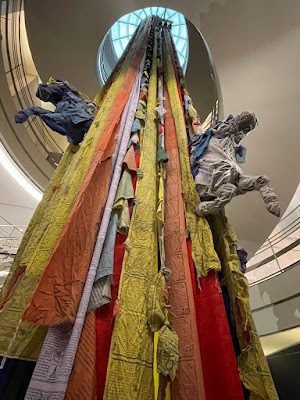Had the great pleasure today of leading the Adult Forum at Church of the Ascension on "Trees and the Sacred." It was nice not just to share my thinking with a new audience, but to do so at the place where the original seed for the whole project may have been planted. It was at one of their Sunday evening Services of Meditation and Sacrament years ago that I first heard Thomas Merton's words
A tree gives glory to God by being a tree...
 Since Ascension, like our church, has been using the special Prayers of the People distributed as part of this month's Season of Creation, I built our discussion around that. We started a round of self-introductions - include "a special tree, a particular tree or tree species" - which elicited all manner of tender stories of relationships with trees. (Recalling that the Anishinaabe call trees "the standing people"I quipped that we'd more than doubled the number of people in our room.) Then I passed out a copy of the Prayers and asked people to find the trees in it. There are none, of course, though "forestry and timber-harvesting" are mentioned. "Indirectly they're everywhere," someone protested.
Since Ascension, like our church, has been using the special Prayers of the People distributed as part of this month's Season of Creation, I built our discussion around that. We started a round of self-introductions - include "a special tree, a particular tree or tree species" - which elicited all manner of tender stories of relationships with trees. (Recalling that the Anishinaabe call trees "the standing people"I quipped that we'd more than doubled the number of people in our room.) Then I passed out a copy of the Prayers and asked people to find the trees in it. There are none, of course, though "forestry and timber-harvesting" are mentioned. "Indirectly they're everywhere," someone protested.
I told them of my distress at discovering the unspoken taking for granted of plants and trees, but also offered a way forward. Turns out these prayers were written about ten years ago, and it's only in these past ten years that our minds have been opened to trees in a big way: Braiding Sweetgrass (2015), The Hidden Life of Trees (2016), The Overstory (2019), In Search of the Mother Tree (2021). Were someone crafting those prayers this year, I suggested, of course they'd include the trees!
I used this as a way of arguing we're at a turning point in our relationships with trees, and not the first. For most of human history, our relationship could be characterized as one of dependence - which calls forth gratitude and care, but, human relationships suggest, anxiety and dissembling too. Next came distance - the forgetting of our constant needy interactions with trees made possible by fossilized trees, although we think of them just as minerals, and start to imagine human life as separate and separable from the rest of life. That illusion of distance is what makes it possible to encounter trees as our introductions had showsn us we do, as unexpected friends, silent witnesses and special companions. Our resonance with trees surprises and delights us because we have forgotten we're in deep relation already. The new phase I called shared destiny, and it partakes both of the growing sense of kinship which work of the last decade has helped us see and feel, and the Anthropocene reality that the consequences of our actions (mainly fueled by fossilized trees!) have created a new and shared precarity for tree people and human people.
We finished back with the Prayers for the People: I invited people to amend them, to "plant trees" in the text, whether by changing or adding words or adding a whole new section. Folks came up with a variety of brilliant ways to do so, corresponding to different understandings of the role of trees in creation. "Creatures" should be replaced with a phrase evoking all the forms of life on earth. Trees and plants make a mineral world livable for animals. Trees, givers of life and beauty, merit our thanks and care. What a delight!
And what fun to be in a church, where, instead of presenting my views in a neutral, secular, implicitly naturalistic way, I could be theological. For instance observe that the discovery of plant intelligence has made clear that ours is just one kind of intelligence - an argument I rehearsed in class two weeks ago - and then add that this might allow us to "triangulate" in theological ways. Or share my experience with the wood of the simple cross used in the Good Friday service, since the cross was the most intimate witness of Christ's passion...
Hope I have further chances to tap into the religion of trees of more congregations!























.jpeg)

























